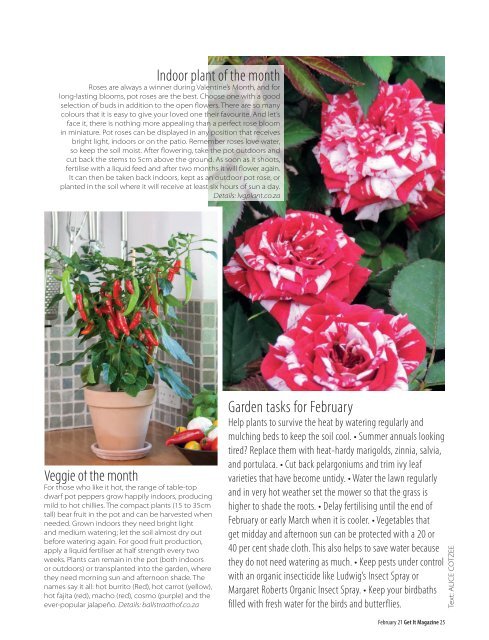JHB North - Feb 2021
Queen of hearts
Queen of hearts
Create successful ePaper yourself
Turn your PDF publications into a flip-book with our unique Google optimized e-Paper software.
Indoor plant of the month<br />
Roses are always a winner during Valentine’s Month, and for<br />
long-lasting blooms, pot roses are the best. Choose one with a good<br />
selection of buds in addition to the open flowers. There are so many<br />
colours that it is easy to give your loved one their favourite. And let’s<br />
face it, there is nothing more appealing than a perfect rose bloom<br />
in miniature. Pot roses can be displayed in any position that receives<br />
bright light, indoors or on the patio. Remember roses love water,<br />
so keep the soil moist. After flowering, take the pot outdoors and<br />
cut back the stems to 5cm above the ground. As soon as it shoots,<br />
fertilise with a liquid feed and after two months it will flower again.<br />
It can then be taken back indoors, kept as an outdoor pot rose, or<br />
planted in the soil where it will receive at least six hours of sun a day.<br />
Details: lvgplant.co.za<br />
Veggie of the month<br />
For those who like it hot, the range of table-top<br />
dwarf pot peppers grow happily indoors, producing<br />
mild to hot chillies. The compact plants (15 to 35cm<br />
tall) bear fruit in the pot and can be harvested when<br />
needed. Grown indoors they need bright light<br />
and medium watering; let the soil almost dry out<br />
before watering again. For good fruit production,<br />
apply a liquid fertiliser at half strength every two<br />
weeks. Plants can remain in the pot (both indoors<br />
or outdoors) or transplanted into the garden, where<br />
they need morning sun and afternoon shade. The<br />
names say it all: hot burrito (Red), hot carrot (yellow),<br />
hot fajita (red), macho (red), cosmo (purple) and the<br />
ever-popular jalapeño. Details: ballstraathof.co.za<br />
Garden tasks for <strong>Feb</strong>ruary<br />
Help plants to survive the heat by watering regularly and<br />
mulching beds to keep the soil cool. • Summer annuals looking<br />
tired? Replace them with heat-hardy marigolds, zinnia, salvia,<br />
and portulaca. • Cut back pelargoniums and trim ivy leaf<br />
varieties that have become untidy. • Water the lawn regularly<br />
and in very hot weather set the mower so that the grass is<br />
higher to shade the roots. • Delay fertilising until the end of<br />
<strong>Feb</strong>ruary or early March when it is cooler. • Vegetables that<br />
get midday and afternoon sun can be protected with a 20 or<br />
40 per cent shade cloth. This also helps to save water because<br />
they do not need watering as much. • Keep pests under control<br />
with an organic insecticide like Ludwig’s Insect Spray or<br />
Margaret Roberts Organic Insect Spray. • Keep your birdbaths<br />
filled with fresh water for the birds and butterflies.<br />
Text: ALICE COTZEE<br />
<strong>Feb</strong>ruary 21 Get It Magazine 25


















